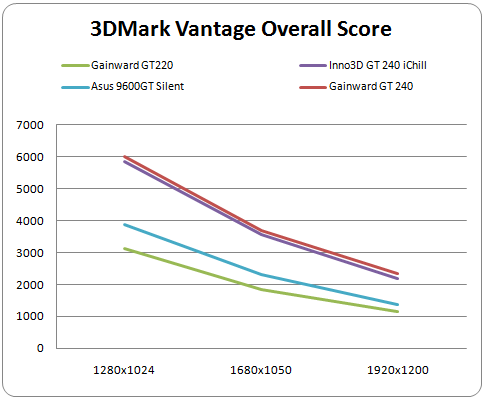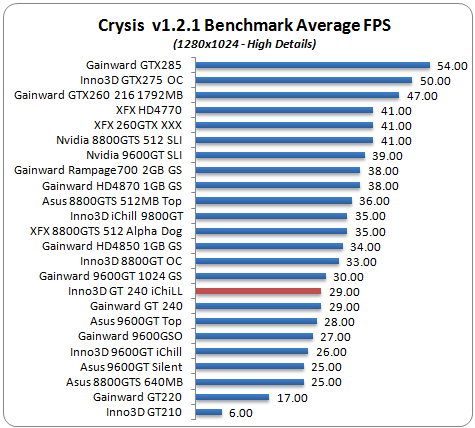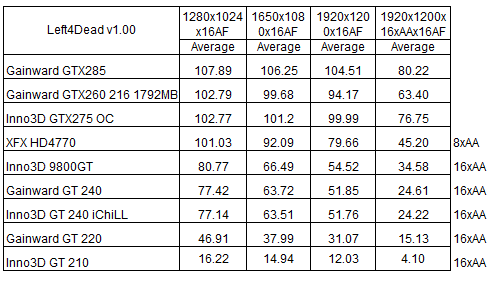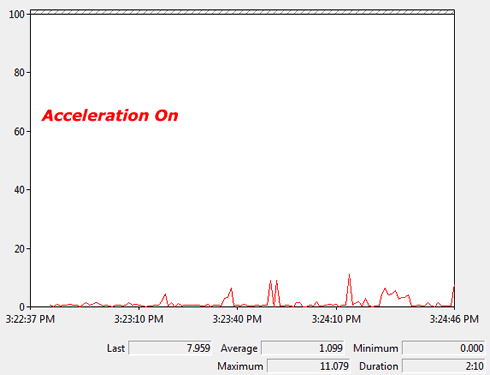1. Features, specifications
We have already tested some products based on the Nvidia GT 240 GPU. Today we will examine another implementation of the GT 240 chip as it has been designed and released by Inno3D. The Inno3D GT 240 iChiLL edition features a more efficient cooler compared to Nvidia's generic design, in an effort to offer a more stable performance as the card comes slightly 'overclocked.'
The Inno3D GeForce GT 240 got the 'i-Chill' treatment with XStriker3. Uniquely designed for passive and active cooling solutions, the Xstriker3 was the first cooler specially designed for Inno3D i-Chill series - built to increase efficient air circulation for extreme gaming. The Inno3D i-Chill GT 240 also features faster core speeds; gold plated DVI+VGA+HDMI connectors for better signal quality; high-quality OS-CON capacitors; aluminum ramsinks to stabilize memory; full game bundles and 3 years warranty.

Inno3D i-Chill Xstricker3 is exclusively assembled with 3 main features which include:
- Air Boost Technology - this is based on Bernoulli's Principle which states that during steady air pressure all air particles that pass any given point follow the same path at the same speed. Hence increase and decrease in the same velocity occurs simultaneously with air pressure or a change in the airflow gravitational potential energy.
- Heatpipe Technology - features copper base heatpipes filled with liquid material that extends directly from the GPU center to provide heat conductivity and vaporizes heat transfer. The Aluminum fins are specially designed to allow air flow pass through easily and remove heat efficiently.
- Silent Cooler with large Air Flow - features combination of passive and active cooling solutions. The silent cooling fan allows air circulation from the center and sides of the card and is built with systematic noise reduction (Fan Speed: 2800rpm Dimension: 7cm Airflow: 16.2 CFM Noise: 28.5dB)
The Inno3D GT 240 iChiLL edition promises to offer a higher performance taking advantage of its 50MHz higher frequency for the core, compared to a reference GT240 solution. It is obvious that the overclocking here is not that high to make a ny significant difference during game play but still, we have to see the benchmarks later on to come up[ with a safe conclusion.
|
GeForce
GT 220 |
Radeon
HD 4670 |
GeForce
GT 240 |
Inno3D
GT 240 iChiLL |
GeForce
9600 GT |
GeForce
9800 GT |
| Shader units |
48 |
320 |
96 |
96 |
64 |
112 |
| ROPs |
8 |
8 |
8 |
8 |
16 |
16 |
| GPU |
GT216 |
RV730 |
GT215 |
GT215 |
G94 |
G92 |
| Transistors |
486M |
512M |
727M |
727M |
505M |
754M |
| Memory Size |
512 MB /
1024 MB |
512 MB |
512 MB /
1024 MB |
512 MB |
512 MB |
512 MB |
| Memory Bus Width |
128 bit |
128 bit |
128 bit |
128 bit |
256 bit |
256 bit |
| Core Clock |
625 MHz |
750 MHz |
550 MHz |
600 MHz |
650 MHz |
600 MHz |
| Memory Clock |
790 MHz |
1000 MHz |
1700 MHz |
1800 MHz |
900 MHz |
900 MHz |
| Price |
$69 - $79 |
$67 |
$99 |
$150 |
$80 |
$90 |
- Retail package
The Inno3D GT 240 iChill XS3 comes in a medium-sized retail box, which is easily recognizable design of the Inno3D iChill products. At the time this article was written, we couldn't find an online price got the product. However, it will not cost you more than €130 Euro (including VAT) since Inno3D has been always following competitive pricing for its products.

The graphics card is well packaged into an anti-static bag. The box also includes a printed manual, a CD-ROM with drivers/software and the retail version of "Alone In The Dark" game. No extra connectors are provided since the card is offering all the available output ports.

The board of the card is not any different than what we have seen with other GT 240 graphics cards, besides the large GPU cooler of course. Later we will see how this GPU cooler performs, although it seems that it does not cover the memory area on the board.


The Inno3D GT 240 iChiLL XS3 has gold-plated outputs that are supposed to introduce less signal noise and of course offers DSub, DVI-D and HDMI outputs allowing you to easily connect it to you monitor.

After installation, the GPU-Z utility confirms the card's specifications. The GPU core runs
at 600MHz, the memory at 1800MHz and the Shaders at 1340MHz - much lower than the Gainward GT 240 GS edition we have already tested. Probably this would also affect overall performance as well.


2. Testing platform
All the test were conducted using the following PC setup:
- Motherboard: Asus Stiker II Extreme Bios 1403 (Nvidia 790i Ultra SLI)
- Processor: Intel Q9300
- Case: Open Air testbed
- Power Supply: OCZ GameXStream GXS600 SLI-Ready
- Memory: 2x1GB Supertalent DDR3-1600 (1333MHz@ 7-7-7-20-1T)
- HDD: WD 200JB 7200RPM
- Monitor: LG L246WH-BH 24"
- Windows VISTA SP2 32bit with all the latest updates installed
- DirectX August 2009
- Nvidia v195.62 with High Quality settings
Many games and applications were used for the evaluation of the performance of each graphics card. In addition we used the FRAPS software to measure the in-game performance when needed.
DirectX 9
- 3DMark 05 v1.3.0
- 3DMark 06 v1.1.0
- Half Life 2: Episode 2
- Crysis v1.2.0 Retail
- Crysis WarHead v1.00 Retail
- Far Cry 2 v1.02 retail
DirectX10
- 3DMark Vantage v1.0.1
- Company Of Heroes v1.7.1
- Crysis v1.2.1 Retail
- Crysis WarHead v1.00 retail
- Far Cry 2 v1.00 retail
- Left4Dead v1.00 retail
- Urinue Benchmark v1.00
- StreetFighter IV Benchmark v1.00
- Stalker: Call Of The Pripyat v1.00
3. Testbed DirectX9/DirectX10
- Testbed DirectX9
For all the tests we used the default settings of the 3DMark05 software as you can see below:

Again we left all the settings to default:


- Testbed DirectX10
We used the three built- in benchmarks to test the performance of each graphics card. We measured the performances at various resolutions using the "Performance" and up to the "Extreme" settings.
- Company Of Heroes (v1.7.1)

We used the built-in benchmark with all the graphics detail settings maxed out.

We used the hocbench Crysis benchmark tool at the resolutions of 1280x1024, 1680x1050 and finally 1920x1200. We run the benchmark software with "High" and "Very High" details enabled in order to identify the optimum settings for a decent game play.

We used the FRAMEBuffer benchmark tool at 1280x1024, 1680x1050 and finally at 1920x1200. All the possible quality levels were set in order to get an idea of what each graphics card can offer.
We used the built-in benchmarking utility and maxed out all visual details, under both DX9/DX10 and settings up to 16x AA/16x AF.

4. Benchmarks - FutureMark Hall Of Fame
The Futuremark benchmarks have been highly discussed among gamers and reviewers. For your information we post the results from 3DMark 05, 3DMark 06 and of course the latest 3DMark Vantage benchmarking software, which give you a rough idea of the performance of each graphics card.
The Inno3D GT 240 iChill XS3 gave a slightly higher performance than the Gainward GT 240 GS:

On the other hand, the Gainward GT 240 GS is faster than the Inno3D GT 240 iChill XS3 at the 3DMark 06 test:

The 3DMark Vantage offers a a clearer view of the card's performance at various resolutions. We can see a small difference in the scores of the two GT240-based cards from Gainward and Inno3D. Their differences in the core/memory/shaders clocks seems to have a affect in the performance while gaming, most of the times in favor of the Gainward card:

5. Benchmarks - Crysis (DirectX10)
- Crysis (DirectX10)
Let's move on with the very demanding "Crysis" game. The majority of the graphics cards appearing in the table below offered acceptable frame rates at 1280x1024 (high quality settings).
Both the Inno3D GT 240 iChiLL and Gainward's GT240 GS gave exactly the same performance around 29.0 FPS:

The cards continued to perorm simiraly when we enabled the "Very high quality" settings. However, the FPS reported for each card make playing impossible, even at 1280 x 1024:



6. Benchmarks - Crysis Warhead (DirectX9, DirectX10), S.T.A.L.K.E.R: Call Of Pripyat Benchmark
- Crysis Warhead (DirectX9, DirectX10)
This is another version of the popular Crysis game, the "Crysis Warhead". Compared to the original game, Crysis Warhead features many visual improvements in both DirectX9 and DirectX10 rendering modes. Below are the test results we wrote down for various resolutions with the anti-aliasing feature disabled.
The Inno3D GT 240 iChill XS3 performs more or less the same as the Gainward GT 240 GS. Their performance is good as soon as you do not set the quality settings any higher than "Mainstream". The "Gamer/Enthusiast" levels are not recommended under both DX9/DX10 rendering modes, as you can see in the results below:

- S.T.A.L.K.E.R: Call Of Pripyat Benchmark
The "Call of Pripyat" benchmark is freely available for everyone in order to have an idea of the visuals of the upcoming game and also test your system with the game and share your score online with other users. We used the highest detail settings under DX10 and a resolution of 1920x1200. The results are very good for the Day/Night/Rain scenarios but rather low at the 'SunShaft' preset. Probably reducing the visual quality settings and the resolution will get you some extra FPS:

7. Benchmarks - Company Of Heroes v1.71 (DirectX 10)
Company Of Heroes is a popular action/strategy game with many fans around the world. The game it was the first ever to utilize the DirectX10 and the game physics are very impressive. We maxed out all the visual details and the built-in benchmark provided the in-game FPS for each card.
The Inno3D GT 240 iChill XS3 gave a marginally lower performance than the Gainward GT 240 GS:



8. Benchmarks - Far Cry 2 (DirectX 9/10), Left4Dead (DirectX 9), StreetFighter IV (DirectX 9)
- Far Cry 2 (DirectX 9/10)
Far Cry 2 is one of the hottest game titles right now. The game supports both DirectX 9 and DirectX10 and its graphics engine is much lighter than the one used by the "Crysis" game title. As a result, most of the graphics cards graphic cards perform very well even at 1920x1200 with 16xAA/16xAF enabled.
Nothing new here. The Gainward GT 240 GS and the Inno3D GT 240 gave similar performance, with the Gainward model to have a slight lead in some cases:

- Left4Dead (DirectX 9)
With the Left4Dead gaming title we used a custom timedemo and measured the performance of the graphics card using the the embedded console, for resolutions up to 1920x1200 with 16xAF enabled and maximized all visual settings.
Again, the Inno3D GT 240 iChill XS3 edition performed as the Gainward GT 240 in all the tested resolutions:

- StreetFighter IV (DirectX 9)
Here are two more benchmarks from the Streetfighter IV and the Unigine benchmark demonstrating the performance of the card in test.

9. CUDA Compatibily
The Inno3D GT 240 iChiLL card support's Nvidia's CUDA technology, which can accelerate various tasks under an appropriate software environment. For example, CUDA could offload the CPU of a system during video playback or encoding. Here we used the CyberLink PowerDVD 9 software, which is compatible with CUDA.



The CPU usage dropped down to 1%, meaning that all the rendering load passed to the GPU leaving our CPU free to deal with other tasks. Low-powered systems (i.e. Intel Atom) would be highly benefited from such a help. CUDA could also help a lot with applications such as Adobe's Photoshop, TMPGEnc etc...
10. Overclocking, final words
- Overclocking
When we had tried to overclock the Gainward GT 240 GS graphics card things were easy. However, we had a hard time to overclock our the Inno3D GT 240 iChill XS3 sample. The system halted after any slight change (boost) of the core/memory/shader clocks. The cause of this behavior could be either the Nvidia 195.62 WHQL or the Nvidia Performance utility we used for overclocking. For the record, we had used the 195.62 beta drivers when we had overclocked the Gainward GT 240 GS series. We should also note that the card's cooling fan could not be controlled via the performance monitor. We should probably wait for a newer version of the RivaTuner software.
- Summary
The Inno3D GT 240 iChill XS3 graphics card is an "enhanced" edition of the Nvidia GT 240 series, featuring improved cooling and gold plated video outputs. The card comes in a complete package and the bundled retail game (Alone In the Dark) could make its purchase even more appealing.
The competition in this s category is very tough. Speaking with numbers, the already tested Gainward GT 240 Golden Sample is "faster" due to its higher clocks for the memory and especially for the shaders. Of course, the differences between the two cards are minor under real gaming. In most cases the difference won't be higher than 1-2 FPS.
We were troubled us with the fact we couldn't overclock the iChiL card using the Nvidia Performance utility and the 195.62 WHQL drivers. However, provided that we have to do with an already overclocked product, this is not something that should be considered as a drawback since the performance gain with in these cases is not worth mentioning.

Concluding this review we can say that the Inno3D GT 240 iChill XS3 is a good example of taking a "normal" product and improve it in several ways. The retail package is complete (compared with other vendors), the installed aftermarket GPU cooler seems to be efficient and quiet, while the supported Nvidia technologies (like CUDA) add some extra value to the card. Provided that do know what to expect in terms of performance form a mid-range graphics card, the Inno3D GT 240 iChill XS3 will do the job for you.
However, our question about the price of the card remains. Many similar products are currently available at the same price range and some of them clearly offer a better (9800GT) or an even better performance (like HD5750).